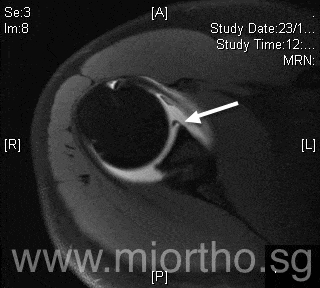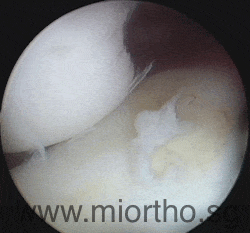The shoulder joint is naturally quite an unstable joint, and is built a little bit like a golf ball (the top of the humerus or arm bone) sitting on a golf tee (the shallow cup of the shoulder blade socket). This natural instability allows our shoulders to have large range of motions in multiple different directions. The shoulder is kept in place by 2 main structures. The muscles surrounding the shoulder are good for slow controlled movements, in which the muscles have time to contract and keep the shoulder in place. During fast movements, often it is the the ligaments and capsule of the shoulder joint that are important in keeping the shoulder in place.

Patients who have their first shoulder dislocation before the age of 25 years, typically have a 80-90% chance of having a repeat dislocation within 2-3 years. Because our joints become stiffer with age, patients who have their first shoulder dislocation after the age of 40 years, have only (but still) a 40% chance of a repeat dislocation. Even if patients don't get a repeat dislocation, many will describe a feeling of apprehension or instability (like the shoulder is "about to come out") on activities of daily living and sports, particularly when the arm is overhead with the hands held behind the head. The arthroscopic image below shows how the shoulder is "falling off the socket" because of a Bankart tear.
The ligaments and capsule are closely related to a ring of cartilage around the rim of the glenoid (shoulder blade socket), this ring is called the labrum. The labrum acts as a firm attachment for the shoulder ligaments, and also acts as a "bumper" to prevent the shoulder from dislocating. It is this labrum that is permanently torn when a person dislocates their shoulder. The MRI image above demonstrates a torn labrum (sometimes called a Bankart tear or Bankart lesion), and joint fluid can be seen leaking between the labrum and the glenoid socket.

Sometimes, the labrum can also be torn by forceful injuries that cause the shoulder to "nearly dislocate"; such as falls, injuries while lifting weights, etc. This can also result in similar symptoms of instability.
Physiotherapy can sometimes help to increase the shoulder stability by increasing the muscle portion of the shoulder stabilisers. Unfortunately, physiotherapy can do little if anything for the loose ligaments and the Bankart tear. If one has repeat shoulder dislocations, or has symptoms of shoulder instability, probably the best form of treatment is arthroscopic ("keyhole") shoulder stabilisation, with repair of the Bankart/labrum tear.
